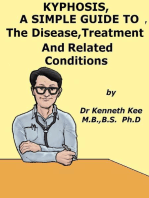Four Myths About Spondylitis: Clinician's Guide
Four Myths About Spondylitis: Clinician's Guide
Uploaded by
Amy YoungCopyright:
Available Formats
Four Myths About Spondylitis: Clinician's Guide
Four Myths About Spondylitis: Clinician's Guide
Uploaded by
Amy YoungOriginal Title
Copyright
Available Formats
Share this document
Did you find this document useful?
Is this content inappropriate?
Copyright:
Available Formats
Four Myths About Spondylitis: Clinician's Guide
Four Myths About Spondylitis: Clinician's Guide
Uploaded by
Amy YoungCopyright:
Available Formats
Clinicians Guide
When Back Pain Means Spondylitis
Four Myths About Spondylitis
Myth: Ankylosing spondylitis and associated diseases are rare. Fact: Spondylitis is more common than multiple sclerosis, cystic fibrosis and Lou Gehrigs Disease combined.
Follow these Pointers to Early Diagnosis
Myth: Spondylitis always results in a fused spine. Fact: Symptoms and severity vary from patient to patient. Many people with spondylitis do not progress to complete bony fusion of the whole spine.
ost cases of spondylitis (ankylosing spondylitis or AS) can be diagnosed, or at least initially suspected, based upon a good history and clinical examination. And yet, delays and failures in diagnosis persist. YOU can help prevent this delay in diagnosis by distinguishing back pain due to spondylitis from other common causes of back pain.
Myth: Spondylitis does not affect women. Fact: Spondylitis affects women about half as frequently as men. However, in women, the symptoms or progression of the disease may be atypical, and the clinician must have a high index of suspicion to prevent unfortunate delays in diagnosis.
IMPORTANT POINTS TO LOOK FOR:
1 Onset is usually under 35 years of age and is insidious. 2 Pain persists for more than three months (i.e. it is chronic). 3 The back pain and stiffness worsen with immobility, especially at night and early morning. 4 The back pain and stiffness tend to ease with physical activity and exercise. 5 NSAIDs are very effective in relieving pain and stiffness in most patients.
Myth: Fact:
Nothing can be done to help the patient. Early diagnosis and proper medical management can minimize back pain and stiffness, and help reduce the risk of disability and deformity.
By diagnosing ankylosing spondylitis early, you can reduce the risk of disability and deformity
Fact: YOU can make a difference.
Look for signs that strengthen the diagnosis Treatment can
SITES OF INFLAMMATION Spondylitis primarily affects cartilaginous joints and entheses, where ligaments, joint capsules and tendons attach to bone, primarily in the spine. Check for pain and tenderness to palpation along the back, pelvic bones, sacroiliac joints, chest and heels. LIMITED MOBILITY Check for limitation of spinal mobility in all directions and for any restriction of chest expansion. X-RAY EVIDENCE OF INFLAMMATION Spondylitis typically begins with inflammation of the sacroiliac joints (sacroiliitis). A presumptive clinical diagnosis of spondylitis can be confirmed by finding erosions and/or narrowing or fusion of the sacroiliac joints on standard AP radiographic view of the pelvis. However, x-rays can be normal in early disease in some patients.
help your patients
Resources for Clinicians
You may wish to refer your patient to a rheumatologist to confirm the diagnosis or to provide overall management in cases that are not well-controlled by conventional treatment.
lthough there is no known cure as yet, spondylitis can be successfully managed to minimize spinal deformity and retard progressive loss of mobility of the spine and other affected joints.
The objectives of treatment reducing pain and stiffness, maintaining erect posture and preserving mobility -- can only be achieved with the patients active participation. Educating patients to their role is essential for success. Most treatment regimens consist of: non steroidal anti-inflammatory drugs (NSAIDs) in doses sufficient to reduce pain and suppress inflammation. encouraging patients to practice good posture habits at all times. initiating an exercise program of stretching and strengthening to keep the spine mobile and erect. practicing deep breathing exercises to help maintain chest expansion.
With medication and exercise, I can continue playing professional baseball.
-Rico Brogna Major League Baseball Player
The American College of Rheumatology at (404) 633-3777 www.rheumatology.org The Spondylitis Association of America at (800) 777-8189 www.spondylitis.org
The Spondylitis Association of America, a national non-profit organization, is the leading information source in the United States for patients with spondylitis, their families and physicians. We will gladly provide your patients with books, pamphlets and videotapes needed to help manage the disease. P.O. Box 5872 Sherman Oaks, CA 91413
Acknowledgements Professional content: Muhammad Asim Khan, MD
Professor of Medicine, Case Western Reserve University
Characteristics of Pain
The back pain of early spondylitis is usually a dull ache, difficult to localize, and felt deep in the buttock or lower back. The back pain is frequently associated with stiffness and spasm of paraspinal muscles, especially in early stages of the disease. Prolonged inactivity usually worsens the pain and stiffness. Pain may awaken the patient at night. Some patients find it necessary to exercise or move about for a few minutes before returning to bed, and may have considerable difficulty in getting out of bed in the morning. Hot showers help minimize the pain and stiffness.
Variations
In children under 17, knee, hip, ankle or foot arthritis may appear as the first symptom. In women, the disease may progress more slowly, and in some, neck and peripheral joint involvement may be the main manifestation. Symptoms may resemble fibrositis or rheumatoid arthritis in some patients. Unilateral acute uveitis occurs in at least 25% of patients with AS, sometimes preceding the onset of spondylitis, and is often recurrent.
Cover illustrations: Teri Farrell Publication supported by a grant from The Entertainment Industry Foundation
Copyright 1998 Spondylitis Association of America
You might also like
- Waiters Postpartal Hemorrhage PDFDocument1 pageWaiters Postpartal Hemorrhage PDFTommieNo ratings yet
- Ankylosing LeafletfaDocument2 pagesAnkylosing LeafletfaAaron NelsonNo ratings yet
- Ankylosing SpondylytiesDocument66 pagesAnkylosing Spondylytiessoumya ranjanNo ratings yet
- Low Back Pain + Spinal StenosisDocument67 pagesLow Back Pain + Spinal StenosiswildanmalikNo ratings yet
- Ankylosing SpondylitisDocument29 pagesAnkylosing SpondylitisKrisna ajiNo ratings yet
- KYPHOSISDocument18 pagesKYPHOSISminangsung minangnengNo ratings yet
- Ankylosing Spondylitis (AS)Document5 pagesAnkylosing Spondylitis (AS)shatabdiNo ratings yet
- The Breakthrough Back Pain Healing and Relief Plan: The book that unlocked the secrets of back pain care, sciatica pain relief naturally via diet, exercises & understanding the mind-body connectionFrom EverandThe Breakthrough Back Pain Healing and Relief Plan: The book that unlocked the secrets of back pain care, sciatica pain relief naturally via diet, exercises & understanding the mind-body connectionNo ratings yet
- Ankylosing Spondylitis (Autosaved)Document25 pagesAnkylosing Spondylitis (Autosaved)realwaseelarh123No ratings yet
- LBP 2Document12 pagesLBP 2Attika DiniNo ratings yet
- Untitled PresentationDocument16 pagesUntitled PresentationtasneemsofiNo ratings yet
- How To Cure Cervical Spondylosis Permanently? - Rela HospitalDocument4 pagesHow To Cure Cervical Spondylosis Permanently? - Rela Hospitaldd2officeNo ratings yet
- Assignment: Cervical SpondylosisDocument14 pagesAssignment: Cervical SpondylosisJaspreet kaurNo ratings yet
- Ankylosing SpondylitisDocument6 pagesAnkylosing SpondylitisAnonymous VzFhQ3iNo ratings yet
- Vdocuments - MX - Biology Investigatory Project by Rajni PriyaDocument25 pagesVdocuments - MX - Biology Investigatory Project by Rajni PriyaRoshan AbbasNo ratings yet
- Peadspresentation FINALDocument20 pagesPeadspresentation FINALhammadptn053No ratings yet
- 11 FinalDocument3 pages11 Finalrehan.rpoNo ratings yet
- Jawahar Navodaya Vidyalaya Kagal KolhapurDocument27 pagesJawahar Navodaya Vidyalaya Kagal KolhapurSujay NirmaleNo ratings yet
- Kyphosis, A Simple Guide To The Disease, Treatment And Related ConditionsFrom EverandKyphosis, A Simple Guide To The Disease, Treatment And Related ConditionsNo ratings yet
- Ankylosing SpondilytisDocument4 pagesAnkylosing Spondilytisandreas kevinNo ratings yet
- Low Back Pain LeafDocument4 pagesLow Back Pain LeafJohn BrittoNo ratings yet
- Handout On Health: Back PainDocument16 pagesHandout On Health: Back Painpkkumar1209No ratings yet
- LBP EmedicineDocument15 pagesLBP EmedicinenararyasriNo ratings yet
- Anky Losing Fact Sheet 2011Document6 pagesAnky Losing Fact Sheet 2011Irwan Santos ONo ratings yet
- Disturbances in Perception and CoordinationDocument17 pagesDisturbances in Perception and CoordinationIris Vanessa MelegritoNo ratings yet
- Ankylosing SpodylitisDocument13 pagesAnkylosing SpodylitisMuzlifah Abdul RahmanNo ratings yet
- Apyogenous Arthritis: Department of Orthopaedics The First Affiliated Hospital Dalian Medical University Tang KaiDocument131 pagesApyogenous Arthritis: Department of Orthopaedics The First Affiliated Hospital Dalian Medical University Tang KaiFathimathNo ratings yet
- Symptoms of Ankylosing Spondylitis KPDocument3 pagesSymptoms of Ankylosing Spondylitis KPlabuansquaremedicalNo ratings yet
- Lec4 Ankylosing SpondylitisDocument25 pagesLec4 Ankylosing Spondylitissana mumtazNo ratings yet
- Ankylosing Spondylitis (Marie-Strümpell Disease/ Bechterew's Disease)Document39 pagesAnkylosing Spondylitis (Marie-Strümpell Disease/ Bechterew's Disease)MoineeNo ratings yet
- Case Study On Spondylosis: DefinitionDocument6 pagesCase Study On Spondylosis: Definitionsai vasavi bandaruNo ratings yet
- Pinal Stenosis TreatmentDocument10 pagesPinal Stenosis Treatmentravideva84No ratings yet
- S Pondy Lols Ys ThesisDocument35 pagesS Pondy Lols Ys ThesisSal LieNo ratings yet
- Types of ScoliosisDocument5 pagesTypes of ScoliosisDimple Castañeto CalloNo ratings yet
- Types of Spine Curvature DisordersDocument7 pagesTypes of Spine Curvature DisordersNicu MacariNo ratings yet
- Unit5 Handicap ModuleDocument14 pagesUnit5 Handicap Moduleted deangNo ratings yet
- Postural Back Pain in Children: DR Igin Ginting SP - OT, MkesDocument24 pagesPostural Back Pain in Children: DR Igin Ginting SP - OT, MkesRin AinochanNo ratings yet
- Patient - Info/doctor/ankylosing Spondylitis ProDocument8 pagesPatient - Info/doctor/ankylosing Spondylitis ProJasleen KaurNo ratings yet
- Back Pain: Back Pain Treatment: Back Pain Relief: How To Heal Back ProblemsFrom EverandBack Pain: Back Pain Treatment: Back Pain Relief: How To Heal Back ProblemsNo ratings yet
- As PPT by LaxitDocument21 pagesAs PPT by LaxitlaxitphysioNo ratings yet
- Osteonecrosis of The HipDocument6 pagesOsteonecrosis of The HipBelle Mae SNo ratings yet
- HDKJFXLDocument6 pagesHDKJFXLpaulNo ratings yet
- Family Medicine DepartmentDocument45 pagesFamily Medicine Departmentسليمان فايزNo ratings yet
- What Is Cervical SpondylosisDocument7 pagesWhat Is Cervical SpondylosisBibhash MishraNo ratings yet
- LimpDocument7 pagesLimpRakesh DudiNo ratings yet
- A Positive Response To Ankylosing Spondylitis: Guidebook For PatientsDocument18 pagesA Positive Response To Ankylosing Spondylitis: Guidebook For PatientsdipanshuroyNo ratings yet
- SpondylolisthesisDocument7 pagesSpondylolisthesisPutri WulandariNo ratings yet
- LOW Back Pain: Pamela Rockwell, DODocument57 pagesLOW Back Pain: Pamela Rockwell, DODania Zaid100% (1)
- The Danger of AnkylosingDocument4 pagesThe Danger of AnkylosingZeeshan IslamNo ratings yet
- Chronic Musculoskeletal Pain in Young Athletes: Eric Small, MDDocument8 pagesChronic Musculoskeletal Pain in Young Athletes: Eric Small, MDАлексNo ratings yet
- Shoulder Impingement Syndrome: Michael C. Koester, MD, Michael S. George, MD, John E. Kuhn, MDDocument4 pagesShoulder Impingement Syndrome: Michael C. Koester, MD, Michael S. George, MD, John E. Kuhn, MDraniNo ratings yet
- Ankylosing Spondilitis Latest 25 SepDocument12 pagesAnkylosing Spondilitis Latest 25 Sepsyafiqa abdullahNo ratings yet
- Ilovepdf MergedDocument40 pagesIlovepdf MergedcbassanteNo ratings yet
- Cervical Stenosis 2006Document16 pagesCervical Stenosis 2006kppsadiNo ratings yet
- Guidebook Guidebook: Answers and Practical Advice Answers and Practical AdviceDocument34 pagesGuidebook Guidebook: Answers and Practical Advice Answers and Practical AdviceluckymaanNo ratings yet
- North American Spine Society Public Education SeriesDocument12 pagesNorth American Spine Society Public Education Serieseryoktadiputra565No ratings yet
- Sathyabama-Spondylitis DissertationDocument104 pagesSathyabama-Spondylitis Dissertationrobinmilton1998No ratings yet
- Low Back Pain: Management Update: DR Dewanta Sembiring, SpsDocument46 pagesLow Back Pain: Management Update: DR Dewanta Sembiring, SpsYoke RetnaningpuriNo ratings yet
- Understanding Ankylosing Spondylitis: Stiffness and Pain in The Lower BackDocument9 pagesUnderstanding Ankylosing Spondylitis: Stiffness and Pain in The Lower BackIonut ManNo ratings yet
- SyringomyeliaDocument3 pagesSyringomyeliaImran TagalaNo ratings yet
- Ankylosing Spondylitis Diet: A Beginner's Quick Start Guide to Managing AS Through Diet, With Sample Recipes and a 7-Day Meal PlanFrom EverandAnkylosing Spondylitis Diet: A Beginner's Quick Start Guide to Managing AS Through Diet, With Sample Recipes and a 7-Day Meal PlanNo ratings yet
- Complicated Sinusitis With Sphenopalatine Artery Thrombosis in A COVID-19 Patient, A Case ReportDocument3 pagesComplicated Sinusitis With Sphenopalatine Artery Thrombosis in A COVID-19 Patient, A Case ReportNurul Aisyah PaldarNo ratings yet
- HerniaDocument13 pagesHerniadocivirusNo ratings yet
- Inadequate Hygiene PracticesDocument4 pagesInadequate Hygiene Practicesjana whiteNo ratings yet
- The Importance of Living A Healthy Lifestyle: Written by Jullie HeinzDocument14 pagesThe Importance of Living A Healthy Lifestyle: Written by Jullie HeinzInisatu DuaNo ratings yet
- Poisons - Matching HeadingsDocument4 pagesPoisons - Matching HeadingsAlejandro FlorezNo ratings yet
- Grade 8 Tle Quarter ExamDocument3 pagesGrade 8 Tle Quarter ExamJovelyn TakilidNo ratings yet
- UntitledDocument6 pagesUntitledRandyNo ratings yet
- Autoimmune DisordersDocument6 pagesAutoimmune DisordersMaquille Ann CervalesNo ratings yet
- Task Analysis: To Investigate The Effects of Changing The Ratio of Sugar in A Cake RecipeDocument3 pagesTask Analysis: To Investigate The Effects of Changing The Ratio of Sugar in A Cake RecipeSebastian CutterNo ratings yet
- GENERAL PATHOLOGY SyllabusDocument3 pagesGENERAL PATHOLOGY SyllabusRana PalNo ratings yet
- Cardiology An Introduction: 12 Cardiomyopathy With Joseph S. Alpert, M.DDocument36 pagesCardiology An Introduction: 12 Cardiomyopathy With Joseph S. Alpert, M.DpasambalyrradjohndarNo ratings yet
- Vertebrobasilar SyndromeDocument14 pagesVertebrobasilar SyndromeHitesh Rohit100% (1)
- Red Book Atlas of Pediatric Infectious Diseases 5th Edition 2023Document903 pagesRed Book Atlas of Pediatric Infectious Diseases 5th Edition 2023Eli PaulaNo ratings yet
- Fluid and Electrolytes - Balance and DisturbancesDocument129 pagesFluid and Electrolytes - Balance and DisturbancesEmmy SaNo ratings yet
- Tuberculosis in ChildrenDocument96 pagesTuberculosis in Childrenped med0% (1)
- Ebola Virus Disease (EVD) : Clinical Features Diagnosis Treatment, Prevention and ControlDocument19 pagesEbola Virus Disease (EVD) : Clinical Features Diagnosis Treatment, Prevention and ControlABc abcNo ratings yet
- Facts or Myth AgingDocument2 pagesFacts or Myth AgingJustine PlazaNo ratings yet
- 20 3 ImageDocument267 pages20 3 Imageakosuanyarko01No ratings yet
- Neonatal Infections - Pathophysiology, Diagnosis, and Management 2018 PDFDocument254 pagesNeonatal Infections - Pathophysiology, Diagnosis, and Management 2018 PDFBao NguyenNo ratings yet
- CholedocholithiasisDocument19 pagesCholedocholithiasisHarold Nathan TanNo ratings yet
- Oral Exam-Oral 2 Primary HealthcareDocument53 pagesOral Exam-Oral 2 Primary HealthcareFloy BatoyNo ratings yet
- Effects of Skipping Breakfast On LongDocument6 pagesEffects of Skipping Breakfast On LongisyraffitriNo ratings yet
- Striano - Can Psychotherapists Hurt You (1988)Document146 pagesStriano - Can Psychotherapists Hurt You (1988)Doron SabariNo ratings yet
- Principles of Infection ControlDocument35 pagesPrinciples of Infection ControlJesus Mario LopezNo ratings yet
- Importance of An Active LifestyleDocument12 pagesImportance of An Active LifestyleJoe LevinneNo ratings yet
- RIMS Thesis TopicsDocument3 pagesRIMS Thesis TopicsroshansanasamNo ratings yet
- Leprosy: Anustha Vishnoi BPT 4 YrDocument33 pagesLeprosy: Anustha Vishnoi BPT 4 YrAnustha VishnoiNo ratings yet
- Psychiatric Nursing PrelimDocument7 pagesPsychiatric Nursing Prelimalexancog456No ratings yet
- ICC3 (109) LGW Haematology Case Studies Tutor Notes ANSWERSDocument26 pagesICC3 (109) LGW Haematology Case Studies Tutor Notes ANSWERSMariam Mokhtar ZedanNo ratings yet

























































































